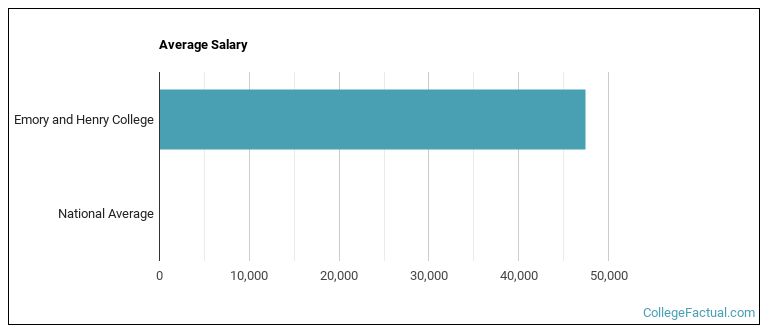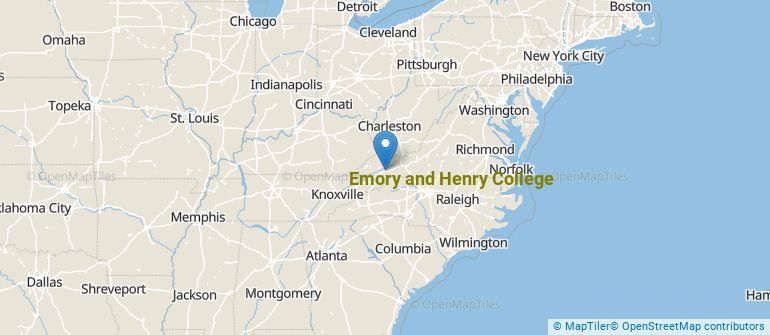 by our College Data Analytics Team
by our College Data Analytics TeamExplore the best ranked schools for the programs you are most interested in.
Emory & Henry College is ranked #1,591 out of 2,152 schools in the nation for overall quality on College Factual's 2025 Best Colleges list. This is an improvement over the previous year, when Emory & Henry College held the #1,661 spot on the Best Overall Colleges list.
Emory & Henry College is also ranked #42 out of 57 schools in Virginia.
The acceptance rate at Emory and Henry College is 97%, which is higher than many other schools to which you may be applying. But don't think getting into Emory & Henry College is a sure thing. The admissions staff is still going to review your application to see if you are a good fit for the school.
At Emory & Henry College, the student to faculty ratio is an excellent 12 to 1. That's much better than the national average of 15 to 1. This indicates that many classes will probably be small, and students will have ample opportunites to work closely with their professors and classmates.
Another measure that is often used to estimate how much access students will have to their professors is how many faculty members are full-time. The idea here is that part-time faculty tend to spend less time on campus, so they may not be as available to students as full-timers.
The full-time faculty percentage at Emory and Henry College is 97%. This is higher than the national average of 47%.
The freshmen retention rate tells us what percentage of first-year, full-time students choose to continue on to their sophomore year at a particular school. The rate at Emory and Henry College is 67%, which is about average when compared to the national rate of 68%.
Students are considered to have graduated on time if they finish their studies within four years. At Emory & Henry College the on-time graduation rate of first-time, full-time students is 46%. That is great when compared to the national average of 33.3%
Find out more about the retention and graduation rates at Emory and Henry College.
During the 2017-2018 academic year, there were 956 undergraduates at Emory & Henry College with 905 being full-time and 51 being part-time.
| $0-30 K | $30K-48K | $48-75 | $75-110K | $110K + |
|---|---|---|---|---|
| $21,732 | $22,345 | $16,887 | $22,241 | $24,527 |
The net price is calculated by adding tuition, room, board and other costs and subtracting financial aid.Note that the net price is typically less than the published for a school. For more information on the sticker price of Emory & Henry College, see our tuition and fees and room and board pages.
It's not uncommon for college students to take out loans to pay for school. In fact, almost 66% of students nationwide depend at least partially on loans. At Emory & Henry College, approximately 64% of students took out student loans averaging $6,247 a year. That adds up to $24,988 over four years for those students.

See which majors at Emory and Henry College make the most money.
Get more details about the location of Emory and Henry College.

Contact details for Emory & Henry College are given below.
| Contact Details | |
|---|---|
| Address: | 30461 Garnand Drive, Emory, VA 24327-0947 |
| Phone: | 276-944-4121 |
| Website: | www.ehc.edu/ |
| Most Popular Majors | Bachelor’s Degrees | Average Salary of Graduates |
|---|---|---|
| Rehabilitation & Therapeutic Professions | 64 | NA |
| Health & Physical Education | 38 | $28,146 |
| Allied Health Professions | 27 | NA |
| Teacher Education Subject Specific | 26 | NA |
| Business Administration & Management | 22 | $35,349 |
| Teacher Education Grade Specific | 22 | NA |
| Accounting | 14 | NA |
| General Biology | 12 | NA |
| General Psychology | 11 | $25,390 |
| Animal Services | 10 | NA |
Online learning is becoming popular at even the oldest colleges and universities in the United States. Not only are online classes great for returning adults with busy schedules, they are also frequented by a growing number of traditional students.
In 2022-2023, 241 students took at least one online class at Emory and Henry College. This is an increase from the 227 students who took online classes the previous year.
| Year | Took at Least One Online Class | Took All Classes Online |
|---|---|---|
| 2022-2023 | 241 | 3 |
| 2021-2022 | 227 | 3 |
| 2020-2021 | 1,087 | 502 |
| 2018-2019 | 21 | 0 |
Learn more about online learning at Emory and Henry College.
If you’re considering Emory and Henry College, here are some more schools you may be interested in knowing more about.
Curious on how these schools stack up against Emory & Henry College? Pit them head to head with College Combat, our free interactive tool that lets you compare college on the features that matter most to you!
Footnotes
*The racial-ethnic minorities count is calculated by taking the total number of students and subtracting white students, international students, and students whose race/ethnicity was unknown. This number is then divided by the total number of students at the school to obtain the racial-ethnic minorities percentage.
References
More about our data sources and methodologies.